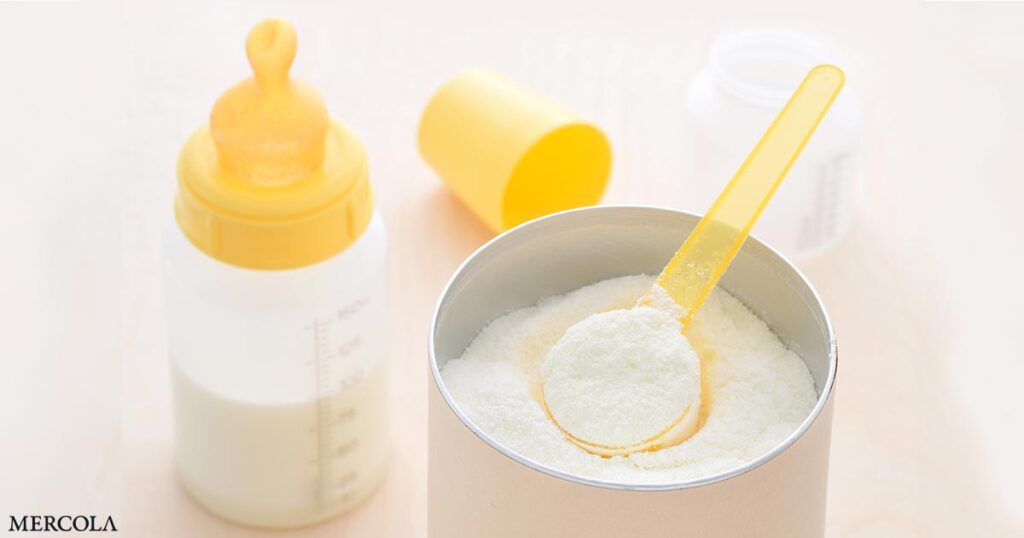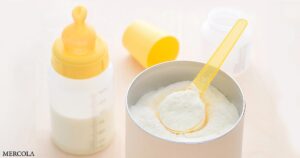The War Against Breastfeeding and the Dangers of Infant Formula

Three years ago, a nationwide infant formula shortage shook America, and before long led to fights at grocery stores1 and stories like this flooding the media:
At the time, significant outrage was directed at the FDA since the shortage was due to their inspection triggering a major recall by one of the leading formula manufacturers (along with tight supplies and subsequent panic buying).
Furthermore, many could not grasp why the FDA was willing to enact such a strong enforcement action against potentially contaminated infant formula which was linked to two deaths. Still, they had no issue with the large numbers of people dying from the COVID vaccines nor the immense degree of contamination and deadly hot COVID vaccine lots the public had discovered.
As I watched this unfold, my thoughts were a bit different. Could there possibly be another way to feed your infants? Perhaps one that you could do at home that did not rely upon an unstable supply chain — but surprisingly, I did not see that offered anywhere (even in homesteading groups).
I thus took the events of 2022 as a remarkable testament to just how effectively the formula industry had convinced mothers they needed to do anything besides breastfeed their children, and since then, have tried to help create a window to end this dysfunctional paradigm.
Fortunately, on March 18th, RFK Jr. announced an FDA initiative2 to make America’s infant formula healthy again (e.g., conducting a comprehensive review of its nutritional content, testing formula for heavy metals, and objectively assessing the health issues that arise from formula feeding). This is extremely important and I believe that for “Operation Stork Speed” to succeed,3 it’s critical for us to understand what went awry with infant formula.
Note: In addition to heavy metals4 (and other harmful chemicals), infant formula has also repeatedly been found to be contaminated with aluminum,5 something which is quite problematic due to its adverse effects on the physiologic zeta potential6 (which can cause microclots in the nervous system).
The History of Formula Feeding
Throughout history and cultures, there are references to (likely malnourished) mothers who could not sufficiently nourish their children with their breast milk, who then sought out milk from other mothers or, if that was not available, from animals.
This process led to a variety of attempts (starting in 1865)7 to create a milk substitute that more accurately matched the safety and efficacy of human breast milk, a process which was revolutionized through the discovery of evaporated milk powder and its adaptation into infant formulas in the early 1900s.
As infant formulas improved in the 1920s,8 manufacturers began targeting physicians with their advertising. By 1929, the American Medical Association (AMA) established a committee to evaluate the safety and quality of formula compositions, leading many companies to seek the AMA’s “Seal of Acceptance,” bringing physicians closer to formula manufacturers.
By the 1940s and 1950s, formula use became widely accepted as a safe alternative to breast milk, and with the help of aggressive marketing and the inappropriate medicalization of childbirth, successfully displaced breastfeeding.9
Note: The AMA’s seal of approval was created in 1905,10 and was designed to be a source of revenue to keep the struggling organization afloat (as it was given in return for advertising dollars rather than any assurance of safety11 — for instance the AMA widely promoted the benefits of smoking their sponsor’s cigarette brand).
Sadly, once this funding allowed the AMA to begin establishing a foothold in the medical market, the organization then switched to blacklisting every competing therapy which would not sell out to the AMA12 (which is essentially why there are so many remarkable forgotten medical therapies exist emerged in the early 1900s).
Many recognized this shift was harmful to both mothers and children, so a variety of groups (particularly the La Leche League13) mobilized the public to support mothers breastfeeding. In the 1970s, they finally reached the public (due to both scientific data emerging in support of breastfeeding and a growing societal dissatisfaction with the paternalistic and insensitive attitude medicine had towards women). Since then breastfeeding has gradually made a comeback.
One of the key events that catalyzed this shift away from formula was the Nestlé formula scandal (which began in 197314), which began after the public learned Nestlé was aggressively targeting poor women in undeveloped countries for infant formula sales.
This was accomplished by paying hospitals to give free samples to mothers after delivery and telling mothers (frequently via sales reps impersonating nurses) that they would not be able to produce enough milk for their babies. This, in turn, created anxiety that suppressed maternal milk production and led to the impoverished mothers frequently not only switching to infant formula but also diluting it (as they could not afford standard doses).
Millions of infants died as a result of these practices,15 and Nestlé eventually came under widespread public scrutiny (e.g., boycotts, celebrity protests, government investigations, and some of its predatory marketing practices being banned).
The fact that Nestlé was able to convince millions of mothers to starve their babies to death again illustrates how predatory many of these marketing tactics were16 (particularly since some of those now outlawed practices still continue in the poorer nations).
Formula Marketing
During pediatric “well-child” visits, doctors frequently diagnose children as underweight based on growth charts and then promote (frequently unnecessary) infant formula17 that routinely contains unhealthy ingredients like obesity promoting corn syrup and seed oils.
Note: This is somewhat analogous to how a widely used (but erroneous) calculator routinely tells patients they are at high risk of a heart attack and hence must start a dangerous and unnecessary statin.
Robert S. Mendelsohn,18 in How to Raise a Healthy Child In Spite of Your Doctor,19 critiqued this, noting industry sponsored growth charts often favor formula-fed children, misclassifying breastfed babies as “underweight.”
This is particularly true for CDC’s charts as their weights are derived from too many formula fed babies,20 and hence can diagnose breastfed babies as “underweight.” Hence, formula-feeding is promoted as the “new normal” despite studies showing it leads to rapid weight gain and adult obesity.21,22,23
As such, the formula’s role in the continually increasing childhood obesity rates24 (e.g., 19.7% in 2020)25 must be considered (but unfortunately, we are instead “solving” it by putting children on Ozempic26 — a drug which has a great deal of issues).
This again illustrates the longstanding tendency of the formula industry to engage in a variety of predatory tactics (e.g., making a variety of false claims not supported by the existing evidence to create parental anxiety, funding pediatrician’s “education,” having the doctors and hospitals push unhealthy infant formula, levying sanctions against countries that promote breastfeeding and lobbying against laws allowing maternity leave27).
Sadly, due to that (and spending 3 billion each year on marketing) the formula industry now has a 10.15% annual growth rate and an annual market worth 90.91 billion.28
So while breastfeeding has many proven health benefits, less than 50% of babies worldwide are breastfed according to WHO recommendations — which results in nearly $350 billion dollars of economic losses annually.29
Seed Oils in Formula
Since seed oils are linked to obesity, inflammation, and metabolic dysfunction, many parents do not want to give them to their children. In turn, I am frequently contacted by frustrated patients after they discover that every infant formula is full of seed oils. This is because:
• FDA regulations require infant formulas to have at least 2.7% of its calories (300 mg per 100 Kcal) come from linoleic acid (LA, the problematic omega-6 fat in seed oils), which the FDA aggressively enforces. The regulations have no upper limit, resulting in some formulas containing over 15% LA.
• The Infant Formula Act of 1980 is the source of that FDA regulation.30
• Its requirements came from 1960s research that erroneously deemed LA essential for infant development (largely because infants consuming no other fats would have their skin dry out).
• Modern science shows that the required amount of LA is much lower once other essential fats are present,31 that high LA blocks the synthesis and accumulation of fats which are critical for brain and eye development (hence impairing neurological development), and that LA increases the brain’s vulnerability to inflammation.32
Because of this, other governments (e.g., China’s33 and Europe’s34) have revised their infant formula requirements. Remarkably however, despite the Infant Formula Act granting H.H.S. Secretaries the authority to update the nutritional requirements of infant formula since 1980, all they’ve done is slightly raise the required phosphorus and calcium and require the addition of selenium to formula (which ultimately happened 26 years after the scientific community concluded it was essential).
As such, many fats we now know are essential for developing infants are largely absent from formula, and simultaneously, LA remains a primary ingredient (likely on account of industry lobbying as LA is one of the cheapest ingredients available to the food industry).
Raw Milk
Throughout history, infants in many societies whose mothers could not produce sufficient milk have gotten supplemental milk from a variety of animals, and in America, prior to World War II, many textbooks advocated for feeding children raw animal milk.35
At the time pasteurization began to be implemented for milk in the late 1800s,36 it was arguably immensely valuable as while millions of children had been successfully raised on raw animal milks, children were also being sickened by microbial contaminated milk (as things were much less sanitary then than they are now and not every children had access to clean cow’s milk).
As such, before long, humanity’s long history of consuming raw milk was forgotten and raw milk came to be viewed as extremely dangerous (largely due to raw milk significantly increasing the risk of causing a listeria infection — something which can be quite hazardous to mothers, children, and the elderly).
However, the data does not support that belief. For example, a (likely biased) 2003 risk assessment from the FDA found many commonly consumed foods (that no one ever objects to) had a much greater risk of causing a listeria infection than raw milk.37
Similarly, a 2007 FOIA request showed that from 1980 to 2005, there had only been three total cases of listeria and two of brucella (all of which came from raw cheese not raw milk) and that all other microbial infections in raw milk (most of which aren’t that dangerous) were also quite rare (typically under a 100 cases per year).38
Note: While raw milk is relatively safe (provided you get it from a clean and grass fed source), there is a small elevated risk of infection from soft raw cheeses.
In contrast, pasteurizing milk damages essential vitamins and denatures proteins, leading to issues such as:
- The loss of beneficial enzymes.
- Denatured proteins lose their negative charge, thereby adversely affecting the physiologic zeta potential (which in turn can create congestion throughout the body).
- Pasteurized milk can turn proteins into allergens, leading to allergies, rashes, and respiratory problems like asthma — whereas raw milk rarely causes those issues.
Note: While still problematic, evaporated milk causes fewer allergies than liquid pasteurized milk. Additionally, some individuals who have difficulty consuming dairy find switching from A1 to A2 milk (which is much rarer than A1 milk) improves their symptoms, while others better tolerate goat’s milk (but also can cause constipation and lacks B₁₂). However, while each can be helpful, in most cases, individuals best tolerate raw milk.
Conversely, the plant “milks” can be quite problematic for infants as they lack many of the essential nutrients found in animal milks and often contain various unhealthy substances. Soy milk is particularly problematic due to the high amount of phytoestrogens soy puts into the bloodstream,39 soy’s effect on thyroid function,40 soy’s frequent contamination with other chemicals (e.g., herbicides), and soy’s tendency to block the absorption of many critical nutrients.41
In short, if a formula is consumed, it is vital that it safely meets an infant’s nutritional needs. Consequently, many have observed, infants fed on those natural formulas (or breast milk) thrive and lack many of the illnesses seen in most infants.
The Benefits of Breast Milk
One of the most reliable approaches for creating a successful business is to replace something (free) that people rely upon with a patentable product. Unfortunately, when this happens, the synthetic substitute is often a meager shadow of what it replaces.
Breast milk, for example, is a complex, nutrient-rich substance that is crucial to infant health and development.42 It contains growth factors, antibodies, cytokines, and enzymes that support the immune system, digestive health, and overall growth.43,44,45,46
MicroRNA47 in breast milk helps regulate gene expression, prevents allergies, and aids in immune development. Unique to breast milk, these components provide immune protection and foster a baby’s development in ways formula cannot fully replicate.48
Breast milk also contains essential fatty acids,49 cholesterol,50 human milk oligosaccharides,51 (and many other unique lipids)52 that are critical for brain development,53 eye development54 and cognitive function (e.g., academic success55).
These nutrients are absent or less abundant in formula, making breast milk a superior choice for infants. Additionally, it offers bioavailable nutrients,56 reducing nutrient competition (e.g., for zinc absorption).57 The benefits of breastfeeding are numerous and include:
• Lower rates of infections (e.g., pneumonia,58 ear infections59) and lower hospitalization rates (e.g., for infections).60
• Lower rates of gastrointestinal issues (e.g., stomach problems,61 constipation,62 gas,63 diarrhea64) and allergies65 (e.g., being half as likely to develop asthma66).
• Being half as likely to die67 from Sudden Infant Death Syndrome68 (a condition decades of evidence shows is linked to vaccination).
• Being less likely to develop cancers69 (particularly leukemia70).
• Improved brain development (particularly white matter growth71).
• Improved cognition (e.g., verbal and spatial skills72 or mathematical ability and working memory73). Likewise, breastfeeding for 12 months was associated with a three-point increase in IQ74 (along with a 0.8 point increase for each additional month75), and higher educational and financial success in life.76
• Being significantly less likely to develop autism or ADHD.77
Breastfeeding also offers significant benefits to the mother, both immediately after pregnancy and later in life. In the short term, it promotes better infant bonding,78 enhances maternal mood,79 aids in post-pregnancy weight loss,80 and reduces the likelihood of developing postpartum depression.81
Additionally, breastfeeding over 12 months of breastfeeding reduces the risk of breast cancer by 4.3%,82 ovarian cancer by 34%83 (and by up to 91% with extended breastfeeding84), and also decreases the risks of endometrial cancer,85 heart attacks,86 and high blood pressure.87
Breastfeeding also promotes stronger bonding, aids in postpartum weight loss, and improves maternal mood. In short, the complexity and richness of breast milk and the mother-child bond it fosters make it an unparalleled source of nutrition, providing essential support for both infant and mother.
As such, it is always imperative that mothers are given the proper support to nourish their children (e.g., lactation consultants can be immensely helpful).
Similarly, one of the most important, but frequently missed points is that the mother needs to be supported as much as possible during the post-delivery process (e.g., with maternity leave and a supportive family), since stress (particularly chronic stress) frequently significantly decreases milk production. In contrast, if her well-being is prioritized, the other necessary areas (e.g., the marriage and the infant’s health) tend to work themselves out.
Conclusion
In my eyes, there are three reasons why the issues I’ve outlined here are so important:
• First, it is a fundamental aspect of human life which (like many other things) industry has usurped from us and replaced with an inferior product that takes away our independence and health.
• Second, our early nutrition during childhood sets the stage for the rest of our lives. As such, we must reclaim a healthy way to raise our children, particularly since many of the principles for a healthy infant diet also hold true for the rest of one’s life.
• Third, infants raised on nutritious breast milk or formula tend to be much healthier, and many people I’ve spoken to over the years notice those differences.
RFK Jr., through his newly enacted “Operation Stork Speed,”88 is taking a stand to reform the formula industry, update the science, and protect our families. For this to succeed, we too must do all we can to make the food we feed our children healthy again, and I am deeply grateful that an opportunity like this is at last before us.
Author’s Note: This is an abridged version of a longer article that goes into greater detail on many of the points discussed here (e.g., the benefit of raw milk and strategies for obtaining the healthiest infant formulas) along with methods for addressing the common challenges encountered with breastfeeding (including colic).
That article can be read here. Additionally, a companion article on the dangers of hospital births and addressing the complications of C-sections and key prenatal strategies for having the healthiest baby possible which can be read here.
A Note from Dr. Mercola About the Author
A Midwestern Doctor (AMD) is a board-certified physician from the Midwest and a longtime reader of Mercola.com. I appreciate AMD’s exceptional insight on a wide range of topics and am grateful to share it. I also respect AMD’s desire to remain anonymous since AMD is still on the front lines treating patients. To find more of AMD’s work, be sure to check out The Forgotten Side of Medicine on Substack.
Test Your Knowledge with Today’s Quiz!
Take today’s quiz to see how much you’ve learned from yesterday’s Mercola.com article.
How might EMR Syndrome affect your life if you experience its symptoms?






